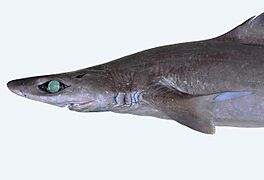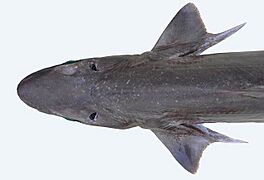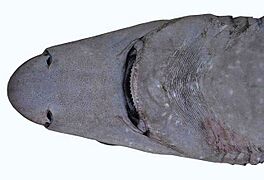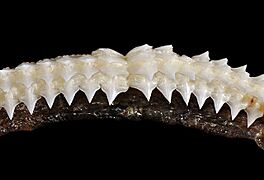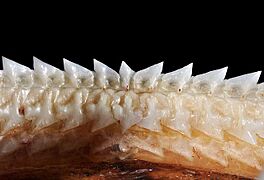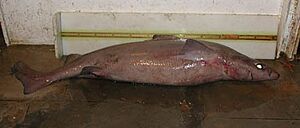Gulper shark facts for kids
Quick facts for kids Gulper shark |
|
|---|---|
 |
|
| Conservation status | |
| Scientific classification | |
| Genus: |
Centrophorus
|
| Species: |
granulosus
|
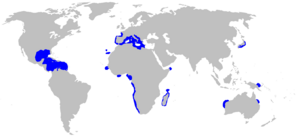 |
|
| Range of gulper shark (in blue) | |
| Synonyms | |
|
Centrophorus acus Garman, 1906 |
|
The gulper shark (Centrophorus granulosus) is a long, thin dogfish shark that usually grows to about three feet long. You can find it in deep, dark waters all over the world. It's light grayish-brown, lighter on its belly, with a long nose and big green eyes. This deep-sea shark has two back fins, each with a long, grooved spine. The second back fin is smaller than the first. Its top teeth are like blades, and its bottom teeth have tiny jagged edges.
This shark eats mostly fish, but also squid and other small sea creatures like crabs and shrimp. The gulper shark is currently an endangered species. This is mainly because people catch too many of them. Also, they have a very long pregnancy and don't have many babies, which makes it hard for their numbers to grow back. Since they live so deep in the ocean, they are not a threat to humans.
Contents
Gulper Shark Reproduction and Life Cycle
Gulper sharks grow up slowly. Female gulper sharks become ready to have babies when they are about 12 to 16 years old. Males mature earlier, around 7 to 8 years old. Scientists can tell if a shark is ready to reproduce by looking at its body.
Size Differences Between Male and Female Sharks
On average, male gulper sharks are smaller than females. An adult male is usually 80 to 95 centimeters (about 2.6 to 3.1 feet) long. An adult female is typically 90 to 100 centimeters (about 3 to 3.3 feet) long. Females might be bigger because they need more space inside to carry their young. It's also thought that bigger sharks might live in deeper waters.
Shark Life Expectancy and Reproduction Rate
Male gulper sharks are often found more often than females, sometimes twice as many. Female gulper sharks can live a long time, between 54 and 70 years. Even though they live long, they don't have many babies. This means if too many are caught by fishing, their population is at a very high risk. It takes a long time for their numbers to recover.
Female gulper sharks usually have only 2 to 10 pups in their entire life. They typically have just one pup at a time during each pregnancy. This is considered a very low number of offspring. After a female's eggs are fertilized, she can hold up to six mature egg cells inside her body. The time these eggs stay inside her body is called the gestation period. Gulper sharks have a very long gestation period, lasting about two years! They can also take long breaks between pregnancies.
Gulper sharks are ovoviviparous. This means the babies grow inside eggs within the mother's body, but they hatch inside her. The mother doesn't provide any care after they are born. When a pup or two forms inside the female, they eat the other fertilized eggs that didn't develop. After they are born, the young sharks are on their own.
Having few babies, a long pregnancy, breaks between pregnancies, and maturing late all mean the gulper shark has a very low reproduction rate. It's believed that the gulper shark has the lowest reproduction rate of any elasmobranch species (a group that includes sharks, rays, and skates).
Where Gulper Sharks Live
The gulper shark is a deep-ocean species. It lives in waters between 100 and 1490 meters (about 330 to 4,890 feet) deep. Younger sharks tend to live in the deeper parts of this range. You can find gulper sharks all over the world in warm and mild waters. They are most often found between 300 and 800 meters (about 980 to 2,620 feet) deep. This is usually along the upper parts of continental slopes and outer continental shelves.
Gulper sharks travel a lot and often swim together in groups. Sometimes, it's hard to count them accurately because they move so much. Also, there are several types of gulper sharks, and sometimes they get mixed up. This can make it hard to know their exact living areas. Gulper sharks really like deep, dark waters.
How Humans Affect Gulper Sharks
Humans mainly interact with gulper sharks through fishing.
Fishing and Accidental Catches
Longline fishing is a common way to catch fish in the deep waters where gulper sharks live. Since gulper sharks are found in many places, this fishing method is used worldwide to catch them. However, gulper sharks are not always the target. Longlines are not very specific, so they can easily catch gulper sharks even when fishermen are trying to catch other species.
When fish are caught that were not intended, it's called bycatch. While bycatch isn't always a big problem for a species, it shows how unpredictable deep-sea fishing can be. It's hard to make rules about bycatch because it's usually accidental. Often, bycatch isn't taken seriously until a species' numbers have dropped a lot. Gulper shark populations have fallen by as much as 80% in some areas, so bycatch is now a big concern for them.
What Gulper Sharks are Used For
People usually take the fins and meat from gulper sharks. But they are especially wanted for the large amount of liver oil they contain. Compared to similar sharks, gulpers have bigger livers with more oil. Shark oil has been used as a traditional medicine. It also contains useful compounds like squalene, which can also be found in plants. This compound makes the gulper shark's liver very valuable and is a main reason why these sharks are specifically fished.
Gulper Shark Ecology and Survival
The way an organism lives its life, from birth to death, is called its life history. The gulper shark's life history shows why it's so vulnerable to fishing. They grow and develop slowly. This means their life strategy is more about competing with each other than about escaping predators, especially humans. Even as babies, they eat other eggs inside their mother, which shows this competitive nature.
Their long pregnancy, few babies, and long lifespan mean they are a "K-selected" species. This type of species focuses on surviving and competing within its own kind. Fishing is a type of predation that slow, invested reproduction cannot easily handle. Their slow reproduction means their population cannot quickly recover. If a group of gulper sharks is heavily fished, it might take fifteen years or more for them to recover, if at all. This is because it takes 12 to 16 years for them to mature. Large gulper shark populations need a long time to build up.
Gulper sharks are top predators in their deep-sea community and don't seem to have natural predators. So, their slow-growing life strategy works well in their natural environment. But when humans start fishing them, it introduces a new, powerful predator. The gulper shark's biology is not prepared to handle this new threat while keeping its population steady.
While fishing for gulper sharks and using their liver oil isn't always bad, catching too many can be a huge problem. The gulper shark is currently listed as "Vulnerable" by the IUCN, not yet "Endangered." However, the demand for squalene from their livers is high, leading to too much fishing. When populations are shrinking due to overfishing, every shark counts. Since up to 80% of gulper populations have disappeared in some areas, any fishing can greatly affect their decline or recovery.
The main issue is that gulper sharks take almost as long as humans to grow up and reproduce. This means that fishing plans for them need to consider a much longer time frame to allow for new generations to grow. Since they don't mature much faster than humans, they need to be fished on a schedule that reflects this. But because humans grow at a similar rate, this is often overlooked. This makes the gulper shark very likely to be overfished, leading to widespread population decline and putting it at risk of becoming endangered.
Conservation Efforts and Laws
The IUCN has classified the gulper shark as vulnerable since 2000. This is because of heavy overfishing, made worse by accidental catches and their low birth rates. In 2005, the General Fisheries Commission for the Mediterranean (GFCM) decided to stop expanding deep-water fishing beyond 1,000 meters (about 3,280 feet). However, this rule doesn't help most gulper sharks, which usually live between 300 and 800 meters deep. This decision also doesn't stop current deep-water fishing; it only prevents new areas from being fished. This isn't enough to help gulper populations that are already struggling.
Many gulper shark populations in other parts of the world have no rules at all. For example, the Northwest Atlantic Ocean has no laws about catching gulper sharks. Their population there has dropped by 80–95% since 1990.
While there aren't many laws just for gulper sharks, some broader laws protect many shark species. The United States Government passed the Shark Conservation Act in 2010. This law made it illegal to remove fins from sharks that were caught, especially those caught by accident, and then sold for shark fin soup. This law helps by requiring that any fins or tails brought to land must still be attached to the shark's body. It also says that no U.S. ship in foreign waters can have loose shark fins. This act protects all shark species within 50 nautical miles of the U.S. coast. This law is much more effective because it directly stops shark finning and helps reduce the number of gulpers killed for their fins.
Challenges in Conservation
Even with conservation efforts, some problems make it hard to protect gulper sharks. These include how fishing rules are set and how catches are checked.
One idea is to manage fisheries carefully, watching the shark population to make sure it doesn't crash. They often use the shark's body weight to decide when to harvest them. But if these ratios are wrong, the fishery can easily fail because sharks are caught before they can reproduce. This is especially true for the gulper shark, with its two-year pregnancy and 12 to 16 years to mature for females.
Scientists have found that the rules for fin-to-body-mass ratios are not right for all shark species. Rules based on a general ratio for all species can actually harm fisheries. The actual fin-to-body-mass ratios vary a lot depending on the species and location. This means current rules might cause fisheries to crash instead of helping populations grow.
Another challenge is identifying different gulper shark species. It's hard to tell the seven local species apart just by looking at them. Scientists are now using DNA to tell the species apart. This helps them monitor recovery plans better. This DNA testing is a reliable way to check what sharks are being caught. However, the DNA samples need to be preserved well, which can be tricky. This method also requires special training, so it's not something fishermen can easily do.
Uncertainties in Data
Even though there's information about gulper sharks, it's not all collected in one place. This means researchers might repeat basic studies instead of going deeper into the subject. Also, some information might be wrong because many Centrophorus sharks look very similar. While new ways like DNA testing are helping to identify different species, older data might have mixed up C. granulosus with other types of dogfish sharks. This also means that current population numbers might include other dogfish, not just gulper sharks. Finally, because gulper sharks travel a lot, their recorded population numbers might not be completely accurate.




